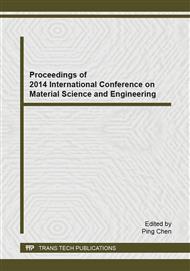[1]
Information on http: /www. epa. gov/ppcp.
Google Scholar
[2]
L.J. Mills, C. Chichester , Review of evidence Are endocrine-disrupting chemicals in the aquatic environment impacting fish populations, Sci. Total Environ. 343 ( 2005) 1-34.
DOI: 10.1016/j.scitotenv.2004.12.070
Google Scholar
[3]
J.E. Harries, D.A. Sheahan, S. Jobling, P. Matthiessen, P. Neall, J.P. Sumpter, T. Tylor, N. Zaman, Estrogenic activity in five United Kingdom rivers detected by measurement of vitellogenesis in caged male trout. Environ. Toxicol. Chem. 16 (1997).
DOI: 10.1002/etc.5620160320
Google Scholar
[4]
C. Purdom, P. Hardiman, V. Bye, N. Eno, C. Tyler, J. Sumpter, Estrogenic Effects of Effluents from Sewage Treatment Works, Chem. Ecol. 8 (1994) 275-285.
DOI: 10.1080/02757549408038554
Google Scholar
[5]
P. Fernández, L. Morales, C. Vázquez, M. Lago, A. M. Bermejo Comparison of two extraction procedures for determination of drugs of abuse in human saliva by high-performance liquid chromatography. J. Appl. Toxicol. 28(2008) 998-1003.
DOI: 10.1002/jat.1365
Google Scholar
[6]
G. Gatidou, N.S. Thomaidis, A.S. Stasinakis, T.D. Lekkas Simultaneous determination of the endocrine disrupting compounds nonylphenol, nonylphenol ethoxylates, triclosan and bisphenol A in wastewater and sewage sludge by gas chromatography–mass spectrometry. J. Chromatogr. A., 1138(2007).
DOI: 10.1016/j.chroma.2006.10.037
Google Scholar
[7]
T.A. Ternes, H. Andersen, D. Gilberg, M. Bonerz, Determination of estrogens in sludge and sediments by liquid extraction and GC/MS/MS. Anal. Chem. 74(2002) 3498-3504.
DOI: 10.1021/ac015717z
Google Scholar
[8]
C. Miége, J. Dugay, M. C. Hennion, Optimization, validation and comparison of various extraction techniques for the trace determination of polycyclic aromatic hydrocarbons in sewage sludges by liquid chromatography coupled to diode-array and fluorescence detection. J. Chromatogr. A, 995(2003).
DOI: 10.1016/s0021-9673(03)00497-7
Google Scholar
[9]
C. Basheer, A.A. Alnedhary, B.S.M. Rao, S. Valliyaveettil , H.K. Lee, Development and Application of Porous Membrane-Protected Carbon Nanotube Micro Solid-Phase Extraction Combined with Gas Chromatography/Mass Spectrometry, Anal. Chem. 78 (2006).
DOI: 10.1021/ac060240i
Google Scholar
[10]
H. Zhang, W.P. Low, H.K. Lee, Evaluation of sulfonated graphene sheets as sorbent for micro-solid-phase extraction combined with gas chromatography–mass spectrometry, J. Chromatogr. A 1233 (2012) 16-21.
DOI: 10.1016/j.chroma.2012.02.020
Google Scholar
[11]
S. Kanimozhi, C. Basheer, K. Narasimhan, L. Liu, S. Koh, F. Xue, M. Choolani, H.K. Lee, Application of porous membrane protected micro-solid-phase-extraction combined with gas chromatography-mass spectrometry for the determination of estrogens in ovarian cyst fluid samples, Anal. Chim. Acta 687 (2011).
DOI: 10.1016/j.aca.2010.12.007
Google Scholar
[12]
Z. Wang, X. Zhao, X. Xua, L. Wu, R. Su, Y. Zhao, C. Jiang, H. Zhang, Q. Ma, C. Lu, D. Dong, An absorbing microwave micro-solid-phase extraction device used in non-polar solvent microwave-assisted extraction for the determination of organophosphorus pesticides, Anal. Chim. Acta 760 (2013).
DOI: 10.1016/j.aca.2012.11.031
Google Scholar
[13]
T.P. Lee, B. Saad, E.P. Ng, B. Salleh. Z. Linde, Type L as micro-solid phase extraction sorbent for the high performance liquid chromatography determination of ochratoxin A in coffee and cereal, J. Chromatogr. A 1237 (2012) 46-54.
DOI: 10.1016/j.chroma.2012.03.031
Google Scholar
[14]
J. Huang, J. Liu, C. Zhang, J. Wei, L. Mei, S. Yu, G. Li, L. Xu, Determination of sulfonamides in food samples by membrane-protected micro-solid phase extraction coupled with high performance liquid chromatography, J. Chromatogr. A 1219 (2012).
DOI: 10.1016/j.chroma.2011.11.026
Google Scholar
[15]
Z.Y. Gu, C.X. Yang, N. Chang, X.P. Yan, Metal_Organic Frameworks for Analytical Chemistry: From Sample Collection to Chromatographic Separation, Accounts Chem. Res. 45 (2012) 734-745.
DOI: 10.1021/ar2002599
Google Scholar
[16]
Y.Y. Zhou, C.Y. Zhang, Z.G. Yan, K.J. Li, L. Wang, Y.B. Xie, F.S. Li, Z. Liu, J. Yang, The use of copper(II) isonicotinate-based micro-solid-phase extraction for the analysis of polybrominated diphenyl ethers in soils, Anal. Chim. Acta 747 (2012).
DOI: 10.1016/j.aca.2012.08.023
Google Scholar
[17]
D.D. Ge, K. L. Hian, Zeolite imidazolate frameworks 8 as sorbent and its application to sonication-assisted emulsification microextraction combined with vortex-assisted porous membrane-protected micro-solid-phase extraction for fast analysis of acidic drugs in environmental water samples, J. Chromatogr. A 1257 (2012).
DOI: 10.1016/j.chroma.2012.08.032
Google Scholar
[18]
T.P. Lee, B. Saad, W.S. Khayoon, B. Salleh, Molecularly imprinted polymer as sorbent in micro-solid phase extraction of ochratoxin A in coffee, grape juice and urine, Talanta 88 (2012) 129-135.
DOI: 10.1016/j.talanta.2011.10.021
Google Scholar
[19]
L. Xu, H.K. Lee, Novel approach to microwave-assisted extraction and micro-solid-phase extraction from soil using graphite fibers as sorbent, J. Chromatogr. A 1192 ( 2008) 203-207.
DOI: 10.1016/j.chroma.2008.03.060
Google Scholar
[20]
K. Ganzler, A. Salgó, K. Valkó, Microwave extraction: A novel sample preparation method for chromatography, J. Chromatogr. A 371 (1986) 299-306.
DOI: 10.1016/s0021-9673(01)94714-4
Google Scholar
[21]
J. Regueiro, M. Llompart, C. Garcia-Jares, R. Cela, Determination of polybrominated diphenyl ethers in domestic dust by microwave-assisted solvent extraction and gas chromatography–tandem mass spectrometry, J. Chromatogr. A 1137 (2006) 1-7.
DOI: 10.1016/j.chroma.2006.09.080
Google Scholar
[22]
M. Shin, M. L. Svoboda, P. Falletta, Microwave-assisted extraction (MAE) for the determination of polybrominated diphenylethers (PBDEs) in sewage sludge, Anal. Bioanal. Chem., 387 (2007) 2923-2929.
DOI: 10.1007/s00216-007-1168-4
Google Scholar
[23]
K. Waizumi, M. Takuno, N. Fukushima, H. Masuda,. Structures of pyridine carboxylate complexes of cobalt(II) and copper(II) J. Coord. Chem. 44(1998), 269-279.
DOI: 10.1080/00958979808023079
Google Scholar


